Authorship
Gucker, Corey; Shaw, Nancy
Publication Date
December 2019
Nomenclature
Limestone hawksbeard (Crepis intermedia A. Gray), belongs to the Asteraceae family and the Psilochaenia section of the Crepis genus (Bogler 2006; Enke 2009). Nomenclature in this review follows Bogler (2006).
Family
Asteraceae – Aster family
Genus
Crepis
Species
intermedia
NRCS Plant Code
CRIN4 (USDA NRCS 2019).
Subtaxa
Crepis intermedia Nuttall var. intermedia (A. Gray) Jepson.
Synonyms
Psilochenia intermedia (A. Gray) W.A.
Common Names
Limestone hawksbeard, gray hawksbeard, small-flower hawksbeard (USDA FS 1937; Bogler 2006; Welsh et al. 2016; Hitchcock and Cronquist 2018)
Chromosome Number
Chromosome numbers are: 2n = 33, 44, 55, 88 (Babcock and Stebbins 1938; Bogler 2006).
Hybridization
Limestone hawksbeard is a polyploid species that resulted from hybrid combinations involving two or three of the following hawksbeard species (Crepis spp.): tapertip hawksbeard (C. acuminata), largeflower hawksbeard (C. occidentalis), slender hawksbeard (C. exilis), Modoc hawksbeard (C. modocensis), or nakedstem hawksbeard (C. pleurocarpa) (Babcock and Stebbins 1938; Cronquist et al. 1994). Ongoing gene flow and intergradations are reported in areas where limestone hawksbeard occurs with any of the aforementioned hawskbeards or bearded hawksbeard (C. barbigera) (Breitung 1957; Whitton et al. 2008).
Distribution
Limestone hawksbeard is a western species occurring in southern British Columbia, Alberta, Saskatchewan, and south to northern New Mexico, Arizona, and central California (Bogler 2006; USDA NRCS 2019). It occurs primarily east of the Cascade Mountains in the Pacific Northwest (Hitchcock and Cronquist 2018). Populations are most abundant in northern California and southern Oregon, becoming local and infrequent eastward (Babcock and Stebbins 1938).
In a study that coupled herbarium records and ecological niche modelling to describe the suitable climates for Great Basin forb species, increasing summer precipitation had a negative effect on the potential climate suitability for limestone hawksbeard in western sagebrush (Artemisia spp.) ecosystems (Barga et al. 2018).
Habitat And Plant Associations
Limestone hawksbeard is one of the more widely distributed hawksbeard species (Babcock and Stebbins 1938). Because it exhibits characteristics of its parent species, it is preadpated to changing conditions and capable of colonizing new habitats. In some parts of its range, this process is considered aggressive. Although most common on arid, well-drained slopes at the lower edge of the ponderosa pine (Pinus ponderosa) forests in bunchgrass and sagebrush communities (Figs. 1 and 2), limestone hawksbeard has ascended higher into the glaciated valleys of the central Sierra Nevada Mountains than any other hawksbeard (Babcock and Stebbins 1938).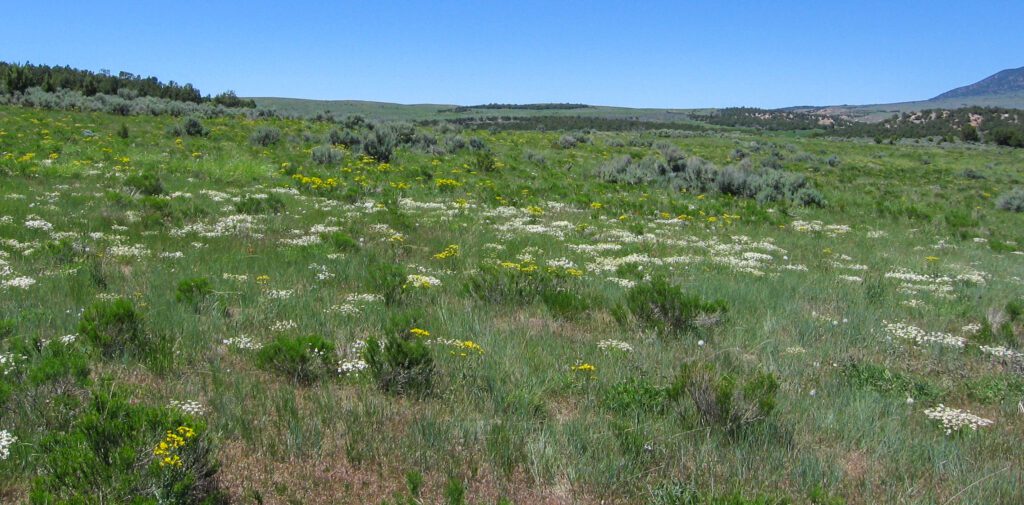
Figure 1. Limestone hawksbeard growing in a big sagebrush/grassland community in Utah. Photo: US Forest Service, Rocky Mountain Research Station, Provo Shrub Sciences Laboratory (USFS RMRS PSSL).
Limestone hawksbeard occupies rocky ridges, dry slopes, and open forests throughout its range. Common plant associates include Sandberg bluegrass (Poa secunda), wheatgrasses (Elymus and Pseudoroegneria spp.), buckwheat (Eriogonum spp.), lupine (Lupinus spp.), arrowleaf balsamroot (Balsamorhiza sagitatta), sagebrush, pinyon (Pinus spp.), juniper (Juniperus spp.), oak (Quercus spp.), and mixed conifers (Standley 1921; USDA FS 1937; Munz and Keck 1973; Bogler 2006; Lesica 2012; Welsh et al. 2016).
Limestone hawksbeard was described as common and showy in dry basin big sagebrush (A. tridentata subsp. tridentata) shrublands occurring from 2,500 to 2,900 ft (760–880 m) in the Glass Mountain region of Mono County, California (Horner 2001). In vegetation descriptions of south-central Nevada, including the Nevada Test Site, limestone hawksbeard occupied an elevation range of 6,000–8,500 ft (1,800–2,600 m). It occurred in singleleaf pinyon-Utah juniper/big sagebrush (P. monophylla–J. osteosperma/A. tridentata) and curl-leaf mountain mahogany (Cercocarpus ledifolius)/big sagebrush communities and white fir (Abies concolor) forests (Beatley 1976).
Elevation
The elevation range for limestone hawksbeard is 1,500 to 12,800 ft (460–3,900 m) (Munz and Keck 1973; Bogler 2006). In Utah it is 5,000 to 8,450 ft (1,525–2,575 m) (Welsh et al. 2016), and in California it is 1,500 to 10,500 ft (460–3,200 m) (Munz and Keck 1973).
Soils
Populations are often associated with well-drained, stony soils (USDA FS 1937), but texture and parent material can vary. Limestone hawksbeard occurred in serpentine soils in the Wentachee and Blue Mountains of Washington and Oregon (Babcock and Stebbins 1938). In California’s Lassen County, populations occupied heavy clay loams near Susanville and light clay loams near Horse Lake. Soils at both sites were nearly neutral with pH of 6.6 to 6.8. In the Sierra Nevada Mountains, limestone hawksbeard was frequent in basaltic and granitic soils (Babcock and Stebbins 1938).
Although more common at lower elevations, limestone hawksbeard is found in the bristlecone pine (Pinus aristata) zone (9,500–10,000 ft [2,900–3,000 m]) of the White Mountains in California. In this area, limestone hawksbeard was restricted to sandstone substrates and did not occur on dolomite or granite (Table 1). Sandstone soils had greater clay and available moisture and were closer to neutral pH than the dolomite and granite soils. Average annual precipitation in the study area from 1953 to 1962 was 12.5 in (318 mm) (Wright and Mooney 1965).
Table 1. Soil characteristics of three substrates in the bristlecone pine zone of the White Mountains in California. Limestone hawksbeard was restricted to sandstone soils (Wright and Mooney 1965).
|
Soil characteristics |
Sandstone |
Dolomite |
Granite |
|
Sand (%) |
63 |
64 |
82 |
|
Silt (%) |
33 |
34 |
15 |
|
Clay (%) |
4 |
2 |
3 |
|
Avail moisture (%) |
25 |
20 |
16 |
|
pH |
6 |
8 |
6 |
In the Jackson Hole region of Wyoming, limestone hawksbeard was common in big sagebrush communities. Soils in these communities had about 1 in (2.5 cm) of litter accumulation, an A horizon of fine sandy loam, which was about 3 in deep (8 cm), followed by a thin B horizon of coarse sandy loam. Beneath the A and B horizons was a very coarse gravelly and stony mass of parent till 10 ft (3 m) or more deep (Reed 1952).
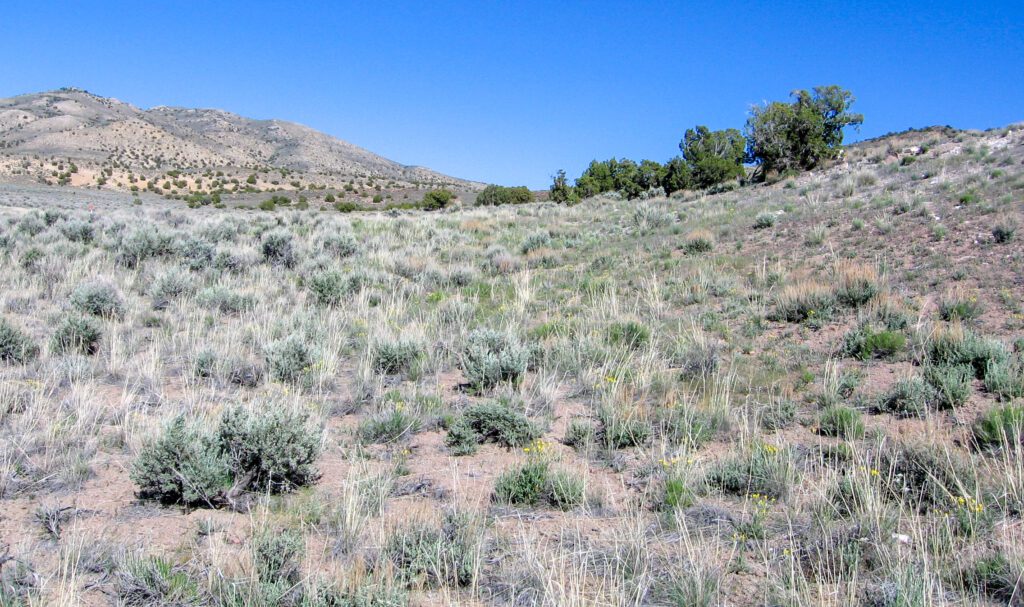
Figure 2. Limestone hawksbeard growing in a big sagebrush community in Utah. Photo: USFS RMRS PSSL.
Description
Limestone hawksbeard is a perennial from a slender to stout taproot and simple to branched caudex (Fig. 3) (Bogler 2006). The caudex, covered by dead basal leaves, gives rise to one or two erect, 10 to 28-in (25–70 cm) tall stems (Babcock and Stebbins 1938; Bogler 2006; Welsh et al. 2016). Stems are branched, often covered in fine soft hairs, and exude a milky juice when damaged (Bogler 2006; Lesica 2012; Welsh et al. 2016).
Plants produce basal and stem leaves. Stem leaves have long petioles that clasp the stems (Babcock and Stebbins 1938; Bogler 2006; Welsh et al. 2016). Lower leaves measure 4 to 16 in (10–40 cm) long and 0.8 to 3.5 in (2–9 cm) wide (Munz and Keck 1973; Bogler 2006). They are elliptic, pointed at the apex, and pinnately lobed half to three quarters of the way to the midvein. The triangular lobes are sometimes toothed (Babcock and Stebbins 1938; Bogler 2006; Lesica 2012; Welsh et al. 2016). Leaves, like the stems, are sparsely to strongly gray tomentose (Fig. 4) (Babcock and Stebbins 1938).
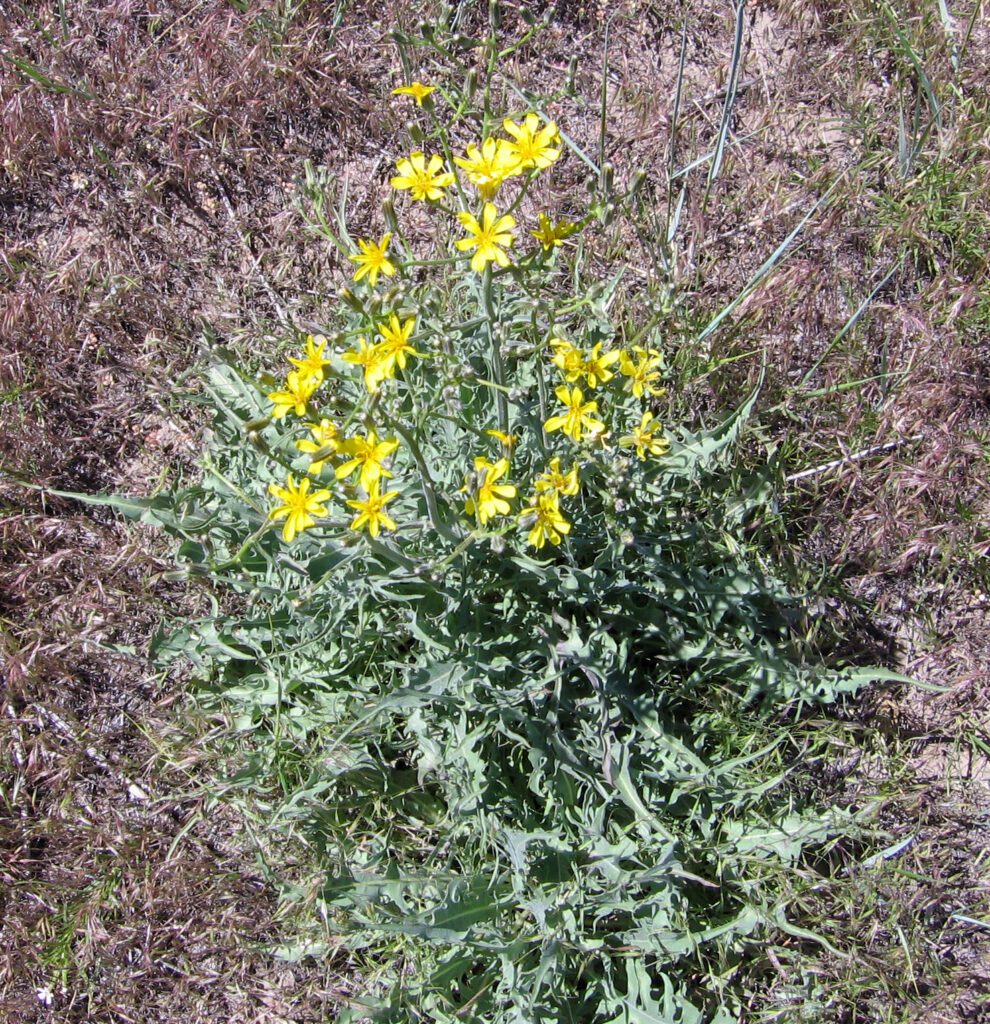
Figure 3. Robust limestone hawksbeard plant growing in Utah. Photo: USFS RMRS PSSL.
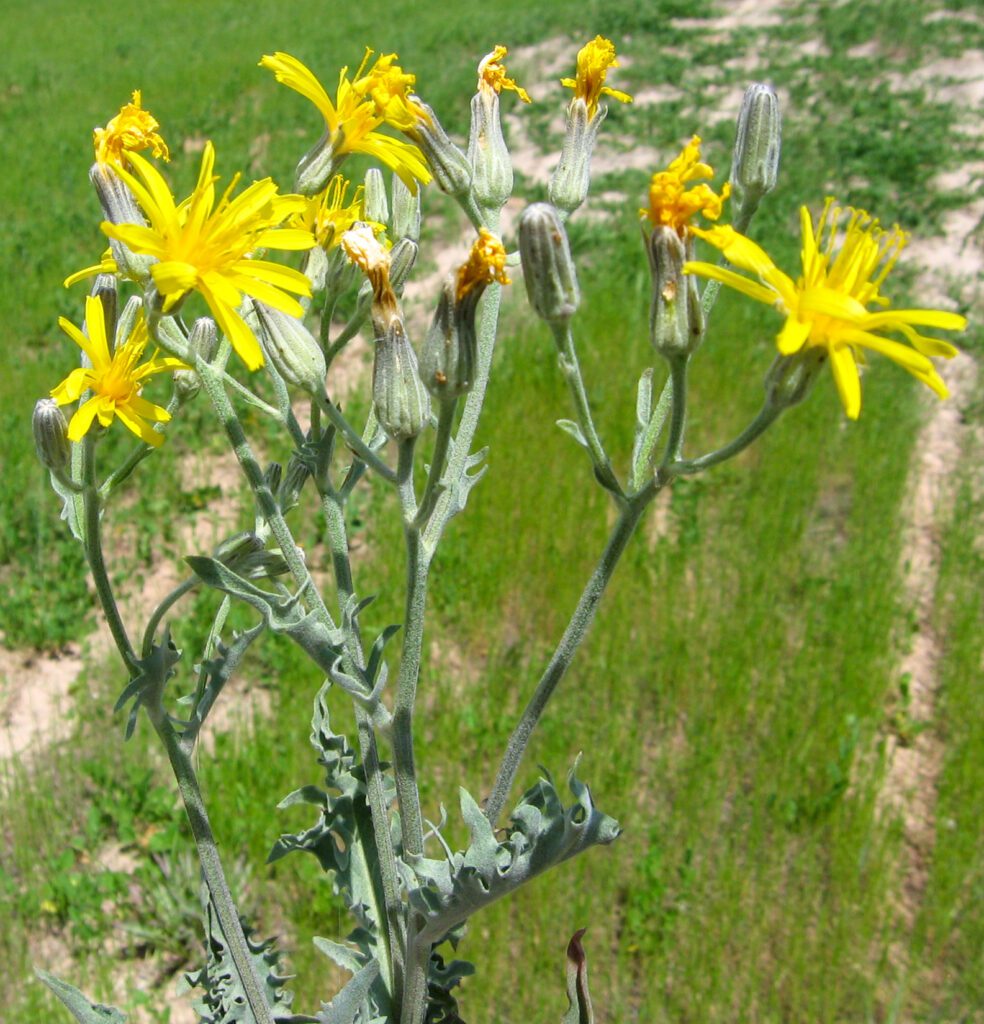
Figure 4. Limestone hawksbeard in flower. Note the indeterminate flowering and gray tomentose look of the stems and leaves. Photo: USFS RMRS PSSL.
Plants produce 10 to 60 flower heads in mostly flat–topped, compound inflorescences (Fig. 4) (Babcock and Stebbins 1938; Bogler 2006). Flower heads contain 7 to 16 florets (Babcock and Stebbins 1938; Munz and Keck 1973). Involucres are narrowly cylindrical, 0.4 to 0.8 in (1–2 cm) tall and less than a third as wide. The outer bracts are less than half as long as the inner bracts (Babcock and Stebbins 1938; Hitchcock and Cronquist 2018). Corollas are yellow and 0.5 to 1.2 in (1.4–3 cm) long (Babcock and Stebbins 1938; Munz and Keck 1973). Anther tubes when well developed are about 0.2-in (0.5 cm) long and typically abort without producing pollen. Style branches are 2.5 to 3.5 mm long (Babcock and Stebbins 1938). The fruit is a subcylindric achene 0.2 to 0.4 in (0.6–1 cm) long with tapered ends. It is yellow to brown with 10 to 12 ribs and a dusky white pappus 0.3 to 0.4 in (0.7–1 cm) long (Babcock and Stebbins 1938; Bogler 2006; Lesica 2012). Limestone hawksbeard represents a somewhat peculiar group of polyploid apomicts, which combine the features of multiple species including tapertip hawksbeard, Modoc hawksbeard, nakedstem hawksbeard, and slender hawksbeard (Babcock and Stebbins 1938). For a description of the many forms and their likely parentage, see Babcock and Stebbins (1938).
Reproduction
Limestone hawksbeard is self-incompatible and facultatively apomictic with a low frequency of sexual reproduction. Most seed is produced asexually, while plants retain the ability to produce sexual offspring (Stebbins and Jenkins 1939). Apomixis is the method of seed production that substitutes sexual reproduction with an asexual reproductive process not involving fertilization, resulting in the production of clones (Stebbins 1941). Insect damage of seeds is common (Babcock and Stebbins 1938).
To assess the evidence of sexual reproduction and gene flow, researchers evaluated patterns of genetic variation at a contact zone for three hawksbeard species in Union County, Oregon. All but 1 of 13 limestone hawksbeard plants sampled produced pollen, but pollen stainability was low (32.5%). They found ten genotypes in the 13 sampled plants using 70 variable randomly amplified polymorphic DNA (RAPD) loci. Limestone hawksbeard and slender hawksbeard were genetically diverse with overlapping patterns of variation suggesting gene flow. Phylogenetic and compatibility analyses indicated that recombination had influenced patterns of genotypic diversity within the samples, and sufficient pollen was available for fertilization of some ovules (Whitton et al. 2008).
Pollination
Limestone hawksbeard flowers are common in June and July (BLM SOS) but may also be seen in May and August (Munz and Keck 1973; Bogler 2006). Although pollination is not required for seed production, plants attract generalist bees and those that specialize on sunflower family (Asteraceae) flowers (St. John and Tilley 2012). Mason bees (Osmia spp.) were the dominant hawksbeard visitors at field evaluations of 19 locations in five states (Cane 2005).
Ecology
In general, hawksbeard seedlings rapidly develop a long slender taproot but aboveground biomass production is slower. Plants are considered long-lived and take 2 to 3 years to produce seed (Babcock and Stebbins 1938; James et al. 2009; Ogle et al. 2012). The limited number of ecological studies available suggest that limestone hawksbeard is found on recently disturbed sites and at some sites it is an aggressive invader (Dalzell 2004; Babcock and Stebbins 1938).
Seed And Seedling Ecology
Limestone hawksbeard seedlings grew slowly in a study comparing the growth rates of native and nonnative species in increased nitrogen (N) environments (James et al. 2009). Native soil and native and nonnative seedlings were harvested from the Northern Great Basin Experimental Range west of Burns, Oregon. Except for arrowleaf balsamroot seedlings, which were obtained commercially. Seedling growth was evaluated after 5 weeks of growth outdoors in large pots (10-in [25 cm] diameter, 12 in [30 cm] deep). Growth and biomass measurements were averaged across treatments. Treatments varied the arrangement, but not the amount, of added N, which was mixed throughout the soil or delivered in 2 or 4 patches. The RGR of limestone hawksbeard averaged a little less than 0.01 g/g/day, which was less than that of all nonnative forbs and most native bunchgrasses evaluated. Root biomass of limestone hawksbeard averaged a little less than 1 g, which was less than that of all nonnative forbs and bunchgrasses. The root mass ratio (biomass allocated to roots relative to total plant biomass) of limestone hawksbeard averaged 0.7 g/g, which was greater than that of all nonnative forbs. All species evaluated, including limestone hawksbeard, acquired more N when it was available in patches than when it was mixed throughout the soil profile (James et al. 2009).
Disturbance Ecology
In two studies, limestone hawksbeard was reported on recently burned sites. In southern Idaho, limestone hawksbeard occurred but was not common on a site burned in August 5 to 6 years earlier. The burned area was aerial seeded with a mix of native and nonnative species that did not include limestone hawksbeard (Dalzell 2004). On the North Rim of Grand Canyon National Park, Arizona, limestone hawksbeard occurred in vegetation that burned frequently (found on up to 22% of plots) but not in long unburned vegetation (Laughlin et al. 2004).
Limestone hawksbeard plays a role in tying up nutrients from deep soil layers in the spring. In a sagebrush community in eastern Oregon (mean 10.6 in [270 mm] annual precipitation), researchers evaluated growth and N uptake of native forbs (limestone hawksbeard and nineleaf biscuitroot [Lomatium triternatum]), bunchgrasses (bluebunch wheatgrass [Pseudoroegnaria spicata], squirreltail [Elymus elymoides], and Sandberg bluegrass), and nonnative annual grasses (cheatgrass [Bromus tectorum] and medusahead [Taeniatherum caput–medusae]). Comparisons were made to assess community resistance to invasion. Leaf biomass production of limestone hawksbeard peaked in May at about 2 g/plant. Forbs had higher rates of leaf production early in the growing season but a shorter period of growth than native bunchgrasses. Forbs and annual grasses acquired a significantly greater proportion of N in April than in May (P < 0.001). Native bunchgrasses acquired a significantly greater proportion of N in May than in April (P < 0.001). Forbs acquired most N in April from deep (6.7–8.6 in [17–22 cm]) soil layers, and bunchgrasses acquired most N in May from shallow layers, suggesting both groups play a role in decreasing N available to native annual grasses. Experimental removal of forbs did not result in a significant increase in the density of medusahead (P < 0.05), but bunchgrass removal did. This was largely attributed to high bunchgrass biomass, which provided for the largest sequestration of N (James et al. 2008).
Wildlife And Livestock Use
Hawksbeard species are components of greater sage-grouse (Centrocercus urophasianus) habitats (Lambert 2005) and important food sources for birds (Young and Young 1986; Pennington et al. 2016).
Livestock feed on limestone hawksbeard, which is considered fairly palatable to cattle and highly palatable to domestic sheep. Palatability is highest in spring and early summer and overgrazing by sheep is possible (USDA FS 1937).
Hawksbeard plants are important in the diets of greater sage-grouse hens and chicks (Drut et al. 1994; Pennington et al. 2016). In southeastern Oregon sagebrush communities, hawksbeard plants were consumed by greater sage-grouse hens in greater proportion than they were available in the vegetation (P < 0.05) (Barnett and Crawford 1994). Diets of 42 hens were evaluated over a 5-week period in big sagebrush and low sagebrush (Artemisia arbuscula) habitats preceding incubation (4 March–8 April) in 1990 and 1991. Hawksbeard leaves together with sagebrush, desertparsley (Lomatium spp.), and long-leaf phlox (Phlox longifolia) made up 84 to 95% of diets. Hawksbeard’s highest frequency in crops was 62%, and it was 14% of the relative dry weight consumed. Hawksbeard plants contained 25 to 30% crude protein, 0.78% calcium, and 0.5% phosphorous (Barnett and Crawford 1994). Greater sage-grouse chicks (average 6 weeks old) in southeastern Oregon also consumed hawksbeard in a proportion that exceeded availability. The highest frequency of hawksbeard in the chick’s diets was 69% (Drut et al. 1994).
Limestone hawksbeard also provides habitat for insects, which are also important components of bird diets. Limestone hawksbeard is a larval host for a moth, Sparganothis tunicana (Tortricidea) (Gilligan and Epstein 2012).
Revegetation Use
Although its use in revegetation has been limited, limestone hawksbeard is an important wildlife species (Drut et al. 1994; Pennington et al. 2016) and has several growth characteristics that suggest the species should persist once established (Babcock and Stebbins 1938). Although seedling growth is slow, individual plants are relatively long-lived (Shock et al. 2018). Long-distance dispersal is facilitated by the production of light-weight seeds with pappi that are carried by the wind (Figs. 5 and 7) (Bogler 2006).
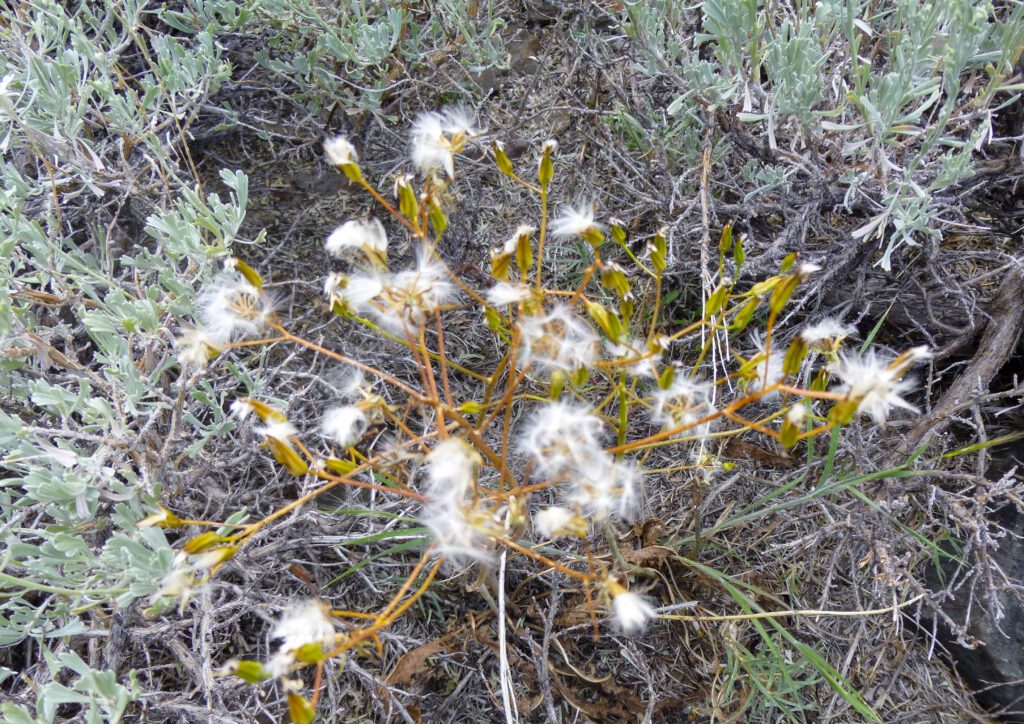 Figure 5. Limestone hawksbeard producing seed in California. Photo: US Department of the Interior, Bureau of Land Management, Seeds of Success (USDI, BLM, SOS) CA 170.
Figure 5. Limestone hawksbeard producing seed in California. Photo: US Department of the Interior, Bureau of Land Management, Seeds of Success (USDI, BLM, SOS) CA 170.
Developing A Seed Supply
For restoration to be successful, the right seed needs to be planted in the right place at the right time. Coordinated planning and cooperation is required among partners to first select appropriate species and seed sources and then properly collect, grow, certify, clean, store, and distribute seed for restoration (PCA 2015).
Developing a seed supply begins with seed collection from native stands. Collection sites are determined by current or projected revegetation requirements and goals. Production of nursery stock requires less seed than large-scale seeding operations, which may require establishment of agricultural seed production fields. Regardless of the size and complexity of any revegetation effort, seed certification is essential for tracking seed origin from collection through use (UCIA 2015).
Seed Sourcing
Because empirical seed zones are not currently available for limestone hawksbeard, generalized provisional seed zones developed by Bower et al. (2014), may be used to select and deploy seed sources. These provisional seed zones identify areas of climatic similarity with comparable winter minimum temperatures and aridity (annual heat:moisture index). In Figure 6, Omernik Level III Ecoregions (Omernik 1987) overlay the provisional seeds zones to identify climatically similar but ecologically different areas. For site-specific disturbance regimes and restoration objectives, seed collection locations within a seed zone and ecoregion may be further limited by elevation, soil type, or other factors.
The Western Wildland Environmental Threat Assessment Center’s (USFS WWETAC 2017) Threat and Resource Mapping (TRM) Seed Zone application provides links to interactive mapping features useful for seed collection and deployment planning. The Climate Smart Restoration Tool (Richardson et al. 2019) can also guide restoration planning, seed collection, and seed deployment, particularly when addressing climate change considerations.
Occurrence Map

Figure 6. Distribution of limestone hawksbeard (black circles) based on geo-referenced herbarium specimens and observational data from 1881-2016 (CPNWH 2017; SEINet 2017; USDI USGS 2017). Generalized provisional seed zones (colored regions) (Bower et al. 2014) are overlain by Omernik Level III Ecoregions (black outlines) (Omernik 1987; USDI EPA 2018). Interactive maps, legends, and a mobile app are available (USFS WWETAC 2017; www.fs.fed.us/wwetac/ threat-map/TRMSeedZoneMapper2.php?). Map prepared by M. Fisk, USDI USGS.
Releases
As of 2020, there have been no limestone hawksbeard germplasm releases.
Wildland Seed Collection
Seed is generally ripe once the dusky white pappus is visible in the seed head (St. John and Tilley 2012), which often occurs in June or July [USDI BLM SOS 2017]. Indeterminate seed set and the high probability of insect damage make planning, monitoring, and inspection important components of wildland seed collection for limestone hawksbeard (St. John and Tilley 2012).
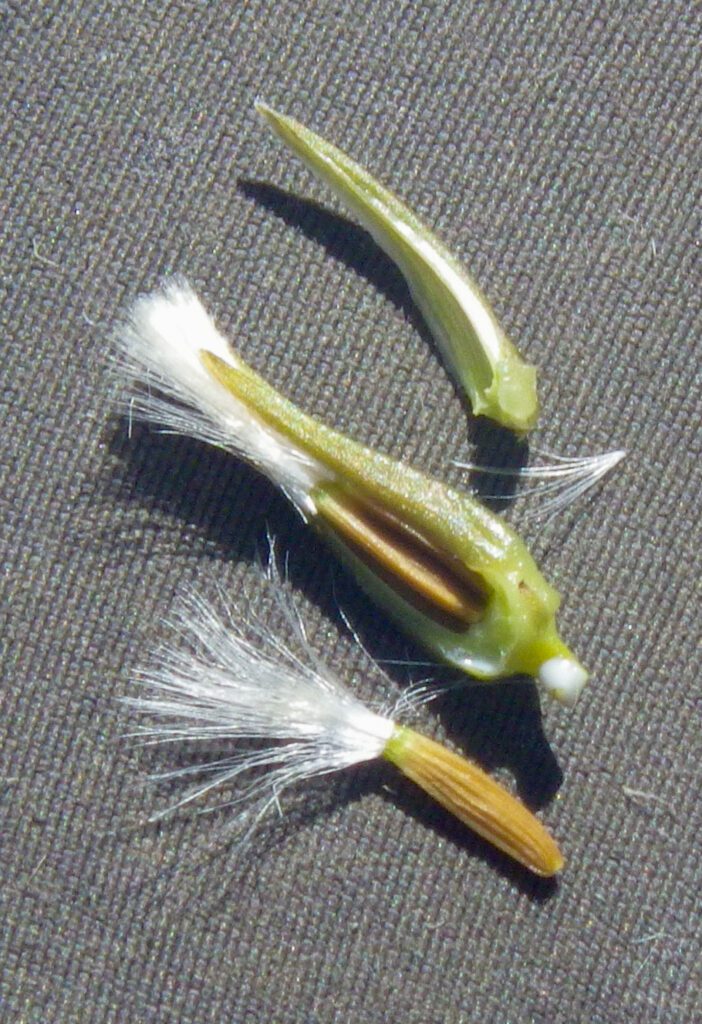
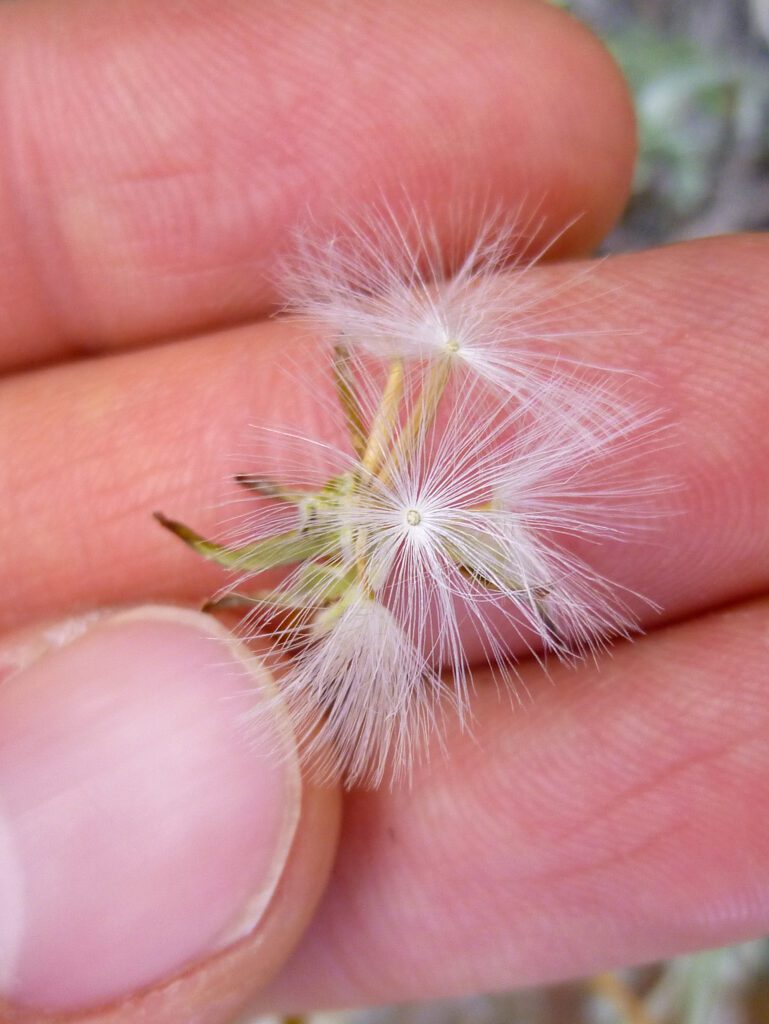
Figure 7. Limestone hawksbeard seed head (left) and individual seeds with pappi (right). Photo: BLM SOS NV030 (left), CA170 (right).
Wildland Seed Certification
Verification of species and tracking of geographic source is necessary whether wildland seed is collected for immediate project use or as stock seed for cultivated increase. This official Source Identification process can be accomplished by following procedures established by the Association of Official Seed Certifying Agencies (AOSCA) Pre-Variety Germplasm Program (Young et al. 2020; UCIA 2015). Wildland seed collectors should become acquainted with state certification agency procedures, regulations, and deadlines in the states where they collect.
If wildland-collected seed is to be sold for direct use in ecological restoration projects, collectors must apply for Source-Identified certification prior to making collections. Pre-collection applications, site inspections, and species and seed amount verification are handled by the AOSCA member state agency where seed collections will be made (see listings at AOSCA.org).
If wildland seed collected by a grower or private collector is to be used as stock seed for planting cultivated seed fields or for nursery propagation (See Agricultural Seed Field Certification section), detailed information regarding collection site and collecting procedures must be provided when applying for certification. Photos and herbarium specimens may be required. Germplasm accessions acquired within established protocols of recognized public agencies, however, are normally eligible to enter the certification process as stock seed without routine certification agency site inspections. For contract grow–outs, however, this collection site information must be provided to the grower to enable certification.
Collection Timing
A good indicator of seed ripeness is visibility of the pappi emerging from closed seed heads. Harvesting before pappus expression dramatically increases the amount of non-viable seed collected (St. John and Tilley 2012). The Bureau of Land Management’s Seeds of Success field crews collected limestone hawksbeard from nine Idaho, Utah, Nevada, and California locations in 2009, 2010, and 2015 [USDI BLM SOS 2017]. Five of the collections were made in June and the other four in July. The earliest collection date was June 12, 2009, from 3,063 ft (934 m) in Ada County, Idaho. The latest collection date was July 15, 2015, from 7,840 ft (2,390 m) in Mono County, California [USDI BLM SOS 2017].
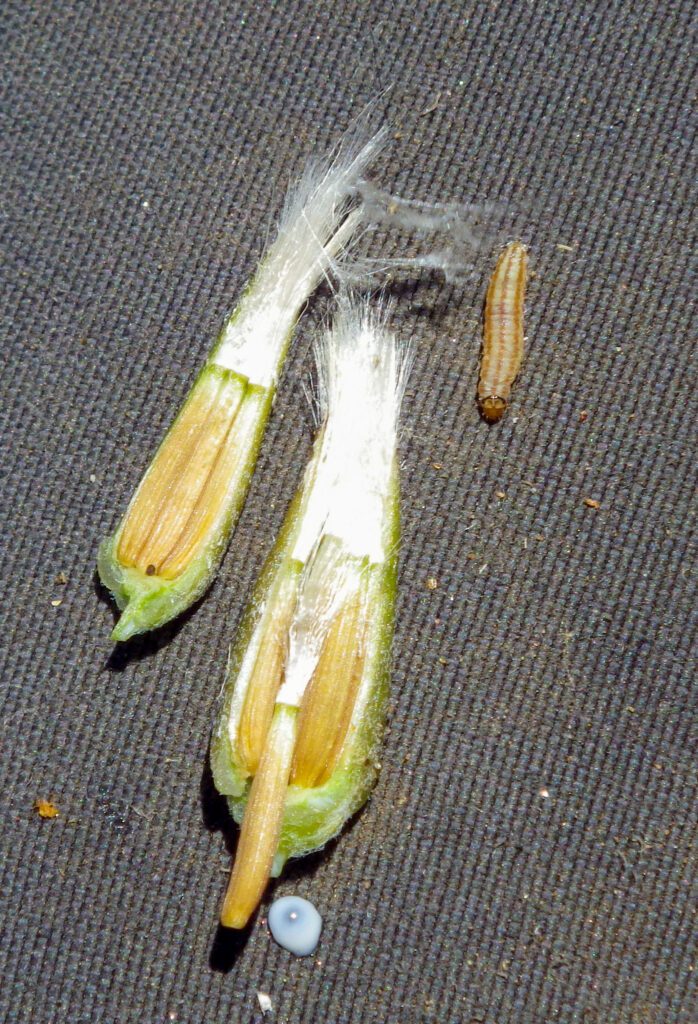
Figure 8. Limestone hawksbeard seed head and emerging insect larva. Photo: BLM SOS NV030.
Collection Methods
Wildland seed can be collected by hand-stripping, using racquets to swat the seed heads over a collection hopper (St. John and Tilley 2012) or by clipping the seed heads (Fig. 8).
Several collection guidelines and methods should be followed to maximize the genetic diversity of wildland collections: 1) collect seed from a minimum of 50 randomly selected plants; 2) collect from widely separated individuals throughout a population without favoring the most robust or avoiding small stature plants; and 3) collect from all microsites including habitat edges (Basey et al. 2015). General collecting recommendations and guidelines are provided in online manuals (e.g., ENSCONET 2009; USDI BLM SOS 2021).
It is critical that wildland seed collection does not impact the sustainability of native plant populations. Collectors should take no more than 20% of the viable seed available at the time of harvest (USDI BLM SOS 2021). Additionally, care must be taken to avoid the inadvertent collection of weedy species, particularly those that produce seeds similar in shape and size to those of limestone hawksbeard.
Post-Collection Management
Any vegetative material (e.g. stems, large leaves) should be removed from collected seed to reduce the moisture content and thus the potential for molding. Keep collections in dry, shaded locations, and do not allowed seed to overheat. Seed should be loosely packed in collection bags to provide good air circulation. Seed can be dried by laying it out in thin layers on screens in a well-ventilated, rodent-free area. Potential seed insects should be controlled using appropriate chemicals or by freezing the seed collection for 48 hours once thoroughly dried. Temporary storage prior to delivery at the seed extractory should be in a cool (< 50 °F [10 °C]), dry (< 35% relative humidity) location.
Seed Cleaning
Limestone hawksbeard seed can be cleaned and the pappus removed (Fig. 9) following the guidelines for cleaning tapertip hawksbeard seed. Seed is first processed using a brush machine with the gate closed to remove the pappus. Final cleaning can be done using a multi–deck air screen cleaner with a 4-mm hole screen on top, 1.4-mm slot screen on the bottom, and light air (Tilley et al. 2012).
Seed Storage
Chromosome aberrations increase as seed of hawkbeard species ages (Nawaschin 1933 cited in Harrington and Kozlowski 1972), but mutation rates are slower when seed is stored at low seed moisture and cool temperatures (Harrington and Kozlowski 1972).
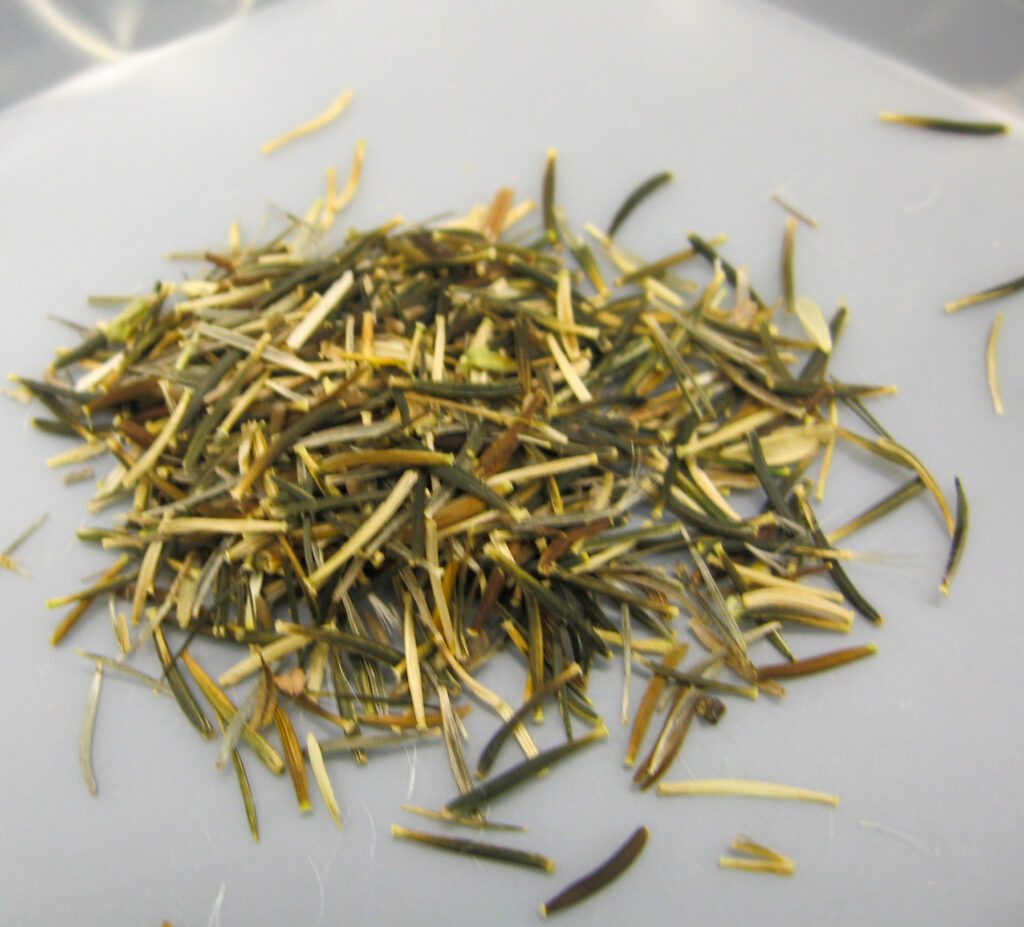
Figure 9. Clean limestone hawksbeard seed. Photo: USFS RMRS PSSL.
Seed Testing
A tetrazolium chloride viability testing procedure was developed by the International Seed Testing Association for the hawksbeard genus (Moore 1985). Purity tests can be conducted using standard procedures. There is no Association of Official Seed Analysts (AOSA) rule for testing germination of Crepis species.
Germination Biology
Although some seed germinates without stratification, best germination occurred after stratification in most studies. Germination of limestone hawksbeard increased with duration of cold stratification for seed collected from multiple populations near Reno and Carson City, Nevada. No after-ripening was required, and variation among populations was apparent. Seed was kept in the dark at 70 °F (21 °C) until germination trials began. Germination was 100% for seed that was stratified for 4 or 6 weeks at 36 °F (2 °C) before being germinated at 59 °F (15 °C) (Barga et al. 2017; Leger and Barga 2017). At the Aberdeen, Idaho, Plant Materials Center (PMC), researchers suggested limestone hawksbeard seed would behave like tapertip hawksbeard seed that germinated at 11% without cold stratification and 75% after 8 months of cold stratification (34 °F [1 °C] in moist peat moss) (St. John and Tilley 2012).
However, in preliminary testing conducted at the National Tree Seed Laboratory (Dry Branch, GA), limestone hawksbeard seed germinated equally well with and without 4 weeks of cold stratification when germinated at 50, 59, or 68 °F (10, 15, or 20 °C) (Karrfalt and Vankus 2012).
Wildland Seed Yield And Quality
Post–cleaning seed yield and quality of seed lots collected in the Intermountain region are provided in Table 2 (USFS BSE 2017). The results indicate that limestone hawksbeard seed can generally be cleaned to high levels of purity, but fill and viability of fresh seed is variable.
A wildland seed collection used to establish limestone hawksbeard production plots had similar pure live seed (84,506 seeds/lb [186,301 seeds/kg) as that reported in Table 2, but viability was much lower (39%). Seed source was not reported (Shock et al. 2011). Limestone hawksbeard seed collected from populations at three sites in northern Nevada for a germination study also had weights (92,570–105,487 seeds/lb [204,078–232,555 seeds/kg]) similar to that reported in Table 2 but viability was lower (42.5–72.5%) (Barga et al. 2017).
Table 2. Seed yield and quality of limestone hawksbeard seed lots collected in the Intermountain region, cleaned by the Bend Seed Extractory, and tested by the Oregon State Seed Laboratory or the USFS National Seed Laboratory (USFS BSE 2017).
|
Seed lot characteristic |
Mean |
Range |
Samples (no.) |
|
Bulk weight (lbs) |
1.17 |
0.28–4.5 |
6 |
|
Clean weight (lbs) |
0.14 |
0.006–0.56 |
6 |
|
Clean–out ratio |
0.097 |
0.02–0.15 |
6 |
|
Purity (%) |
97.3 |
95–99 |
6 |
|
Fill (%)¹ |
85.5 |
75–97 |
6 |
|
Viability (%)² |
85 |
70–97 |
5 |
|
Seeds/lb |
120,039 |
96,508–144,366 |
6 |
|
Pure live seeds/lb |
95,097 |
80,680–110,110 |
5 |
¹ 100 seed X–ray test
² Tetrazolium chloride test
Marketing Standards
Acceptable seed purity, viability, and germination specifications vary with revegetation plans. Purity needs are highest for precision seeding equipment used in nurseries, while some rangeland seeding equipment handles less clean seed quite well.
Viability of wild-collected limestone hawksbeard seed can be highly variable (Shock et al. 2011; Barga et al. 2017). For tapertip hawksbeard, Walker and Shaw (2005) recommended 80 to 90% viability and 90% purity as marketing standards.
Agricultural Seed Production
There are several challenges to agricultural production of limestone hawksbeard seed. At the Aberdeen PMC, field establishment was difficult, plants took several years to produce seed, seed was prone to insect damage, and because of indeterminate seed ripening, multiple harvests were needed to maximize seed yields (St. John and Tilley 2012). In seed production plots grown at Oregon State University’s Malheur Experiment Station (OSU MES) near Ontario, Oregon (Fig. 10), limestone hawksbeard began producing seed in its third year. Seed yield averaged 100 to 350 lbs/ac (112–392 kg/ha) for 3 years, before production plots were tilled under, meaning stands may have been capable of producing seed beyond 3 years. Seed was harvested multiple times using a leaf blower in vacuum mode in the first harvest year and in single mechanical harvest in the next 2 years (Shock et al. 2018).
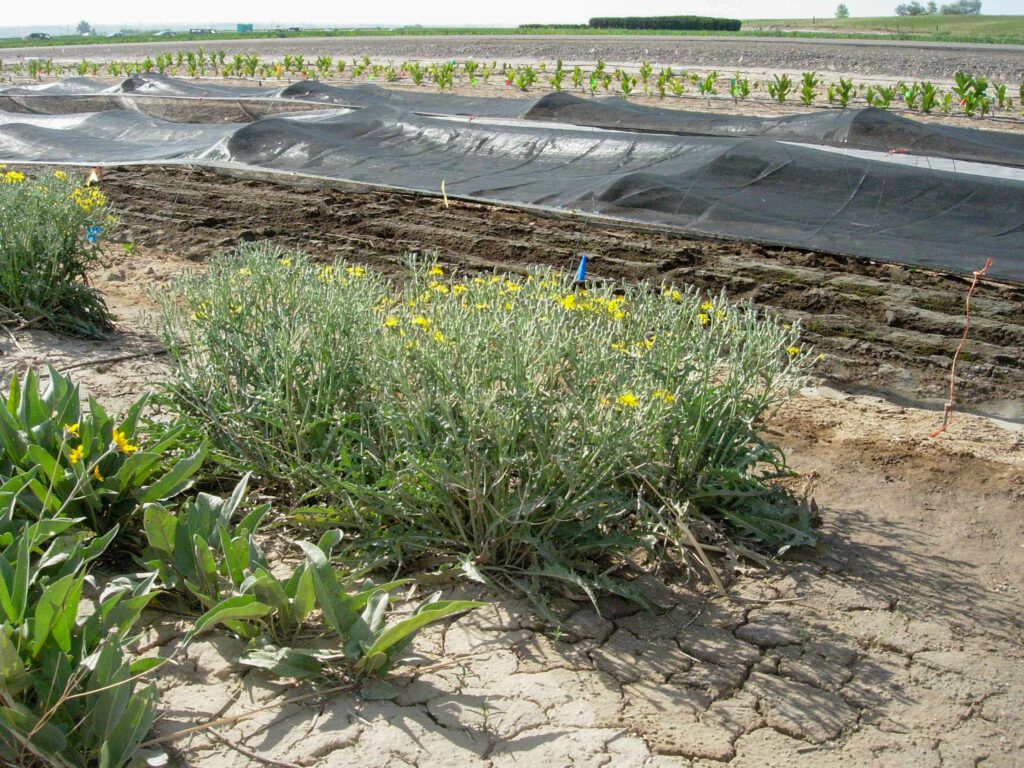
Figure 10. Limestone hawksbeard production plots growing at Oregon State University’s Malheur Experiment Station near Ontario, OR. Photo: N. Shaw, USFS.
Agricultural Seed Certification
In order to minimize genetic changes in specific accessions of native species when increased in cultivated fields, it is essential to track the geographic source and prevent inadvertent hybridization or selection pressure. This is accomplished by following third party seed certification protocols for Pre-Variety Germplasm (PVG) as established by the Association of Official Seed Certification Agencies (AOSCA). AOSCA members in the U.S., Canada, and other countries administer PVG requirements and standards that track the source and generation of planting stock. Field and cleaning facility inspections then monitor stand establishment, proper isolation distances, control of prohibited weeds, seed harvesting, cleaning, sampling, testing, and labeling for commercial sales (Young et al. 2020; UCIA 2015).
Seed growers apply for certification of their production fields prior to planting and plant only certified stock seed of an allowed generation (usually less than four). The systematic and sequential tracking through the certification process requires preplanning, knowing state regulations and deadlines, and is most smoothly navigated by working closely with state certification agency personnel. See the Wildland Seed Certification section for more information on stock seed sourcing.
Site Preparation
At OSU MES, emergence of limestone hawksbeard was improved when seeds were covered with sawdust mulch and row cover (Shock et al. 2011). Seeded areas were weed–free, silt loam soils with pH of 8.3 and 1.1% organic matter (Shock et al. 2018). Soil crusting and bird damage were causes of poor stand emergence in earlier fall seedings of forbs at OSU MES, but researchers observed natural emergence of seed from established perennials when fallen seed was covered by thick layers of organic debris (Shock et al. 2011). They began tests of various seed protection measures, including row cover (N–sulate, DeWitt Co, Sikeston, MO) to protect against soil desiccation and bird damage; sawdust (0.26 oz/ft [18.7 g/m] of row) to mimic the protection of organic debris; sand (same application rate as sawdust, and applied on top of sawdust where both were used) to hold seed in place; and fungicide seed pre–treatment (3.5 oz [100 g] each of Metalaxyl [Ridomil] and Captan in 2 pints [1 l] of water) to protect from damping off. Row cover and sawdust improved emergence of limestone hawksbeard most, and fungicide did not appear necessary. Seeding occurred on November 12, 2009. Plots were drip irrigated for 24 hours on November 20, 2009, and emergence results evaluated on March 10, 2010. Results are provided in Table 3 (Shock et al. 2011).
Table 3. Emergence of limestone hawksbeard 4 months after fall seeding with various combinations of seed protection treatments (Shock et al. 2011).
|
Row cover |
Sawdust |
Sand |
Fungicide seed trt |
Emergence (%)* |
|
Yes |
Yes |
Yes |
Yes |
76.6a |
|
Yes |
Yes |
No |
Yes |
64.5b |
|
Yes |
Yes |
No |
No |
86.2a |
|
Yes |
No |
No |
Yes |
57.6b |
|
No |
Yes |
No |
Yes |
38.6c |
*Emergence percentages followed by different letters are significantly different (P < 0.05).
Weed Management
Weed management is important to successful establishment. Hand removal, pre-emergent herbicide, and physical barriers have been used to control weeds in limestone hawksbeard production plots. At Fountain Green Experimental Farm (FGEF) in Utah, limestone hawksbeard emergence following November seeding was poor because of weed competition, and stands were tilled under in July of the next year (Vernon et al. 2007).
At OSU MES, limestone hawksbeard stands were hand weeded for the majority of their 7 years of growth, except for one year when the pre-emergent, pendimethalin, was broadcast at 2 pints/ac (2.3 l/ha) to control weed emergence in established stands. Success of the weed treatments was not reported (Shock et al. 2018).
Various weed barriers were evaluated on production plots in Utah. Limestone hawksbeard plugs grown in the greenhouse over the 2005–06 winter were planted into holes in the weed barrier in May 2006. Despite difficulties with installation and maintenance of the barriers, which included flooding and high winds, plants produced leaves in the first season. Survival to the following spring was 28% in plots without weed barrier, 13% with a plastic barrier, and about 50% with a woven lumite weed barrier fabric. Survival was significantly better (P < 0.05) with fabric than with plastic, but not significantly different than with no barrier. Weed barriers reduced the amount of hand weeding, which was extensive in the no barrier plots (Meyer and Vernon 2008).
Seeding
Fall seeding was used to establish limestone hawksbeard seed production plots at OSU MES and at FGEF. At OSU MES, limestone hawksbeard was seeded in late November with a small-plot grain drill. Seed was deposited on the soil surface at 20 to 30 seeds/ft (66–98 seed/m) of row, and rows were spaced 30 in (76 cm) apart. A narrow band of sawdust was applied over the seed at 0.26 oz/ft (18.7 g/m) of row, and the plots were covered with N-sulate row cover (Shock et al. 2018). At FGEF, limestone hawksbeard was direct seeded in November using a precision planter. Seeding in spring was a complete failure (Vernon et al. 2007).
Establishment And Growth
Predation on seedlings and seed heads can limit establishment, growth, and seed yield. At OSU MES, row cover was used to protect seedlings from birds until March, when it was replaced with bird netting. As seedlings emerged, bird seed was provided away from the production plot as a way to reduce predation by California quail (Callipepla californica). For growth maintenance, limestone hawksbeard stands were fertilized (50 lb N, 10 lb P, and 0.3 lb Fe/ac [56 kg N, 11 kg P, 0.3 kg Fe/ha]) in their second year through 12-in (30 cm) deep drip tape. Iron (0.3 lb Fe/ac [0.3 kg/ha]) was applied again in the third and last production year (Shock et al. 2018).
Greenhouse grown plants were used to establish production fields at Ephraim, Utah. Limestone hawksbeard plants were more robust with better survival and more early flowers than tapertip hawksbeard plants planted at the same time. Some limestone hawksbeard plants flowered within two years of planting (Vernon et al. 2007), and most were flowering by their third year. Aphids and other seed head predators reduced seed production (Meyer and Vernon 2008).
Irrigation
Added irrigation significantly increased limestone hawsbeard seed production in 2 of 4 years at OSU MES (Table 6; Shock et al. 2018). Irrigation trials began in March 2013 in plots seeded in late November 2011. Treatments of 0, 4, or 8 in (101 or 203 mm) of water were delivered at about 2-week intervals beginning at the time of bud formation and flowering (see Table 4) through drip tape buried 12 in (30 cm) deep. In 2015, the year with the highest number of growing degree days, seed yield was significantly increased to 176.6 lb/ac (198 kg/ha) with 8 in (203 mm) of water applied (Tables 5 and 6). In 2018, a year with below average spring precipitation, seed yield was significantly increased to 151.0 lbs/ac (169 kg/ha) with 4 in (101 mm) of water applied (P = 0.1) (Tables 5 and 6; Shock et al. 2018).
Pest Management
Limestone hawksbeard is a host for several fungal species (Farr and Rossman 2017), and in common gardens in Ephraim and Fountain Green, Utah, newly emerging stands were decimated by flea beetles and there was no survival to next season (Jones and Whittaker 2009). Although a documented host for Puccinia crepidis–acuminatae, P. crepidis–montanae, P. dioicae, P. hieraciata, and P. hieracii (Garrett 1914; Farr and Rossman 2017), the extent that these organisms reduce seed production has not been reported.
Seed Harvesting
At OSU MES, limestone hawksbeard flowered and produced seed the third year after fall planting. Seed was harvested weekly using a leaf blower in vacuum mode in the first production year (2015). In 2016, three years after irrigation trials were started, flowering duration was shorter and more uniform. This made it possible to harvest once by mowing and bagging plants just before seed heads opened. Single annual mechanical harvest yields were similar to that of multiple hand harvests in 2015 (Table 6). Immature (light yellow) and mature (brown) seed from the machine harvest in 2016 was analyzed for viability (TZ). Of the 2016 harvest, 23% of seed was immature, and viability tested indicated that 5% of immature seed was viable. The rest of the harvest (77%) was mature, and 57% of mature seed was viable (Shock et al. 2018).
Table 4. Timing of flowering and seed harvest dates in 2015 to 2018 for seed production fields growing over 4 years at Oregon State University’s Malheur Experiment Station in Ontario, OR (Shock et al. 2018). Seed yields are provided in Table 6.
|
Year |
Start of flowering |
End of flowering |
Harvest date(s) |
|
2015 |
Apr 28 |
June 1 (peak flowering May 5) |
Weekly June 1–July 2 |
|
2016 |
Apr 29 |
May 25 |
May 26 |
|
2017 |
May 5 |
June 7 |
June 8 |
|
2018 |
May 5 |
May 25 |
May 31 |
Table 5. Precipitation (in) and growing degree days (°F) in 2015 to 2018 at Oregon State University’s Malheur Experiment Station in Ontario, OR (Shock et al. 2018).
|
Year |
Spring |
Winter + Spring |
Fall + Winter + Spring |
Growing degree hrs (50–86 °F) Jan–June |
|
2015 |
3.2 |
5.9 |
10.4 |
1610 |
|
2016 |
2.2 |
5.0 |
10.1 |
1458 |
|
2017 |
4.0 |
9.7 |
12.7 |
1196 |
|
2018 |
1.9 |
4.9 |
5.8 |
1342 |
|
5-yr ave |
2.4 |
5.6 |
9.3 |
1207 |
Seed Yields And Stand Life
Limestone hawksbeard first produced seed in the third year after seeding (Shock et al. 2018). Seed yields ranged from 55.5 to 301.5 lbs/ac (62–338 kg/ha) (Table 6). Stands produced harvestable seed for at least 4 years, but seed yield can be variable (Shock et al. 2018).
Table 6. Seed yield (lbs/ac) for showy goldeneye stands with and without growing season irrigation at Oregon State University’s Malheur Experiment Station in Ontario, OR (Shock et al. 2018).
|
Year* |
0 in |
4 in |
8 in |
|
––––––––––lbs/ac–––––––– |
|||
|
2015** |
68.6a |
55.5a |
166.3b |
|
2016 |
83.6 |
87.0 |
77.8 |
|
2017 |
301.5 |
268.1 |
287.1 |
|
2018 |
98.3a |
151.0b |
100.2a |
|
Ave |
138.0 |
140.4 |
155.5 |
*Seed was hand harvested (blower in vacuum mode) weekly in 2015 and was machine harvested once before seed heads opened in 2016–2018.
**Values within a row followed by different letters are significantly different (P ≤ 0.1).
Nursery Practice
Although plugs were used to establish seed production stands and for revegetation studies, guidelines for nursery production were not reported. However, researchers at the Aberdeen PMC suggest the procedures used to grow tapertip hawksbeard would apply to limestone hawksbeard. They planted stratified seed 0.2 to 0.5 in (0.6–1.3 cm) deep in potting soil in the greenhouse. They noted that the long delicate taproot produced was easily damaging during transplanting (St. John and Tilley 2012).
Wildland Seeding And Planting
Outcomes of seeding limestone hawksbeard for revegetation were not reported in the literature, but some guidance on seeding rates, depths, timing and locations has been proposed based on seed size and experience gained in establishment of seed production plots. Based on the weight of limestone hawksbeard seed, the full seeding rate recommended for 25 seeds/ft² (269/m²) is 13 PLS/ac (14.6 kg/ha) (St. John and Tilley 2012). This rate would be adjusted according to its desired proportion in a seed mix, which Ogle et al. (2012) recommended should be less than 10% for hawksbeard species. Seeding in fall in fine sandy loam to silty soils at a depth of 0.13 to 0.25 in (0.3–0.6 cm) is recommended. Grazing should be deferred for at least two growing seasons in revegetated areas (Ogle et al. 2012; St. John and Tilley 2012). Vigor of hawksbeard seedlings is generally low, but plants are long lived (Ogle et al. 2012).
Use of plugs in a revegetation study was somewhat successful in an exclosure in Wells, Nevada, where limestone hawksbeard survival was 38% one year after planting (Meyer and Vernon 2008).
Acknowledgements
Funding for Western Forbs: Biology, Ecology, and Use in Restoration was provided by the USDI BLM Great Basin Native Plant Materials Ecoregional Program through the Great Basin Fire Science Exchange. Great thanks to the chapter reviewers: Shaun Bushman, USDA, Agricultural Research Service and Scott Jensen, USDA FS Rocky Mountain Research Station.
This research was supported in part by the USDA Forest Service, Rocky Mountain Research Station. The findings and conclusions in this publication are those of the authors and should not be construed to represent any official USDA or U.S. Government determination or policy.
Literature Cited
Babcock, E.B.; Stebbins, G.L. 1938. The American species of Crepis: Their interrelationships and distribution as affected by polyploidy and apomixis. Pub. No. 504. Washington, DC: Carnegie Institution of Washington. 199 p.
Barga, S.; Dilts, T.E.; Leger, E.A. 2017. Climate variability affects the germination strategies exhibited by arid land plants. Oecologia. 185: 437-452.
Barga, S.C.; Dilts, T.E.; Leger, E.A. 2018. Contrasting climate niches among co-occurring subdominant forbs of the sagebrush steppe. Diversity and Distributions. 24(9/10): 1291-1307.
Barnett, J.K.; Crawford, J.A. 1994. Pre-laying nutrition of sage grouse hens in Oregon. Journal of Range Management. 47(2): 114-118.
Basey, A.C.; Fant, J.B.; Kramer, A.T. 2015. Producing native plant materials for restoration: 10 rules to collect and maintain genetic diversity. Native Plants Journal. 16(1): 37-53.
Beatley, J.C. 1976. Vascular plants of the Nevada Test Site and central-southern Nevada: Ecologic and geographic distributions. Springfield, VA: U.S. Department of Commerce, Office of Technical Information, Technical Information Center. 308 p.
Bogler, D.J. 2006. Crepis. In: Flora of North America Editorial Committee, ed. Flora of North America North of Mexico. Volume 19 Magnoliophyta: Asteridae, part 6: Asteraceae, part 1. New York, NY: Oxford University Press: 214-228.
Bower, A.D.; St. Clair, J.B.; Erickson, V. 2014. Generalized provisional seed zones for native plants. Ecological Applications. 24(5): 913-919.
Breitung, A.J. 1957. Annotated catalogue of the vascular flora of Saskatchewan. The American Midland Naturalist. 58(1): 1-72.
Cane, J.H. 2005. Pollinator and seed predator studies. In: Shaw, N.; Pellant, M., eds. Great Basin Native Plant Selection and Increase Project: 2004 Progress Report. Boise, ID: U.S. Department of Agriculture, Forest Service, Rocky Mountain Research Station: 7-24.
Consortium of Pacific Northwest Herbaria [CPNWH]. 2017. Seattle, WA: University of Washington Herbarium, Burke Museum of Natural History and Culture. http://www.pnwherbaria.org/index.php
Cronquist, A. 1994. Volume five: Asterales. In: Cronquist, A.; Holmgren, A.H.; Holmgren, N.H.; Reveal, J.L.; Holmgren, P.K., eds. Intermountain flora: Vascular plants of the Intermountain West, U.S.A. Bronx, NY: The New York Botanic Garden. 496 p.
Dalzell, C.R. 2004. Post-fire establishment of vegetation communities following reseeding on southern Idaho’s Snake River Plain. Boise, ID: Boise State University. Thesis. 112 p.
Drut, M.S.; Pyle, W.H.; Crawford, J.A. 1994. Technical note: Diets and food selection of sage grouse chicks in Oregon. Journal of Range Management. 9(1): 90-93.
Enke, N. 2009. Contributions towards a revised infrageneric classification of Crepis (Cichorieae, Compositae). Willdenowia. 39(2): 229-245.
European Native Seed Conservation Network [ENSCONET]. 2009. ENSCONET seed collecting manual for wild species. Edition 1: 32 p.
Farr, D.F.; Rossman, A.Y. 2017. Fungal databases, U.S. National Fungus Collections. U.S. Department of Agriculture, Agricultural Research Service. https://nt.ars-grin.gov/fungaldatabases/.
Garrett, A.O. 1914. The smuts and rusts of Utah: II. Mycologia. 6(5): 240-258.
Gilligan, T.M.; Epstein, M.E. 2012. TortAI, Tortricids of agricultural importance to the United States (Lepidoptera: Tortricidae). Fort Collins, CO: Identification Technology Program (ITP), USDA/APHIS/PPQ/CPHST. http://idtools.org/id/leps/tortai/.
Harrington, J.F.; Kozlowski, T.T. 1972. Chapter 3: Seed storage and longevity. In: Kozlowski, T.T., ed. Seed biology. New York, NY: Academic Press: 145-245.
Hitchcock, C.L.; Cronquist, A. 2018. Flora of the Pacific Northwest: An illustrated manual. Second Ed. Giblin, D.E.; Legler, B.S.; Zika, P.F.; Olmstead, R.G., eds. Seattle, WA: University of Washington Press. 882 p.
Horner, M.A. 2001. Vascular flora of the Glass Mountain region, Mono County, California. Aliso. 20(2): 75-105.
James, J.J.; Davies, K.W.; Sheley, R.L.; Aanderud, Z.T. 2008. Linking nitrogen partitioning and species abundance to invasion resistance in the Great Basin. Oecologia. 156(3): 637-648.
James, J.J.; Mangold, J.M.; Sheley, R.L.; Svejcar, T. 2009. Root plasticity of native and invasive Great Basin species in response to soil nitrogen heterogeneity. Plant Ecology. 202(2): 211-220.
Jones, C.; Whittaker, A. 2009. Native plant material development and seed and seeding technology for native Great Basin forbs and grasses. In: Shaw, N.; Pellant, M., eds. Great Basin Native Plant Selection and Increase Project: 2008 Progress Report. Boise, ID: U.S. Department of Agriculture, Forest Service, Rocky Mountain Research Station: 45-48.
Karrfalt, R.; Vankus, V. 2012. Development of germination protocols, seed weight, purity, and seed conditioning/cleaning protocols for Great Basin grasses and forbs. In: Shaw, N.; Pellant, M., eds. Great Basin Native Plant Selection and Increase Project: 2011 Progress Report. Boise, ID: U.S. Department of Agriculture, Forest Service, Rocky Mountain Research Station: 36-39.
Lambert, S. 2005. Guidebook to the seeds of native and non-native grasses, forbs and shrubs of the Great Basin. Boise, ID: U.S. Department of the Interior, Bureau of Land Management, Idaho State Office. 136 p.
Laughlin, D.C.; Bakker, J.D.; Stoddard, M.T.; Daniels, M.L.; Springer, J.D.; Gildar, C.N.; Green, A.M.; Covington, W.W. 2004. Toward reference conditions: Wildfire effects on flora in an old-growth ponderosa pine forest. Forest Ecology and Management. 199(1): 137-152.
Leger, E.; Barga, S. 2017. Species and population-level variation in germination strategies of cold desert forbs. In: Kilkenny, F; Halford, A.; Malcomb, A., eds. Great Basin Native Plant Project: 2016 Progress Report. Boise, ID: U.S. Department of Agriculture, Forest Service, Rocky Mountain Research Station: 39-46.
Lesica, P. 2012. Manual of Montana vascular plants. Fort Worth, TX: Botanical Research Institute of Texas (BRIT) Press. 779 p.
Meyer, T.; Vernon, J. 2008. Native plant material development and seed and seeding technology for native Great Basin forbs and grasses. In: Shaw, N.; Pellant, M., eds. Great Basin Native Plant Selection and Increase Project: 2007 Progress Report. Boise, ID: U.S. Department of Agriculture, Forest Service, Rocky Mountain Research Station: 7-24.
Moore, R.P. 1985. Handbook on tetrazolium testing. Zurich, Switzerland: International Seed Testing Association. 99 p.
Munz, P.A.; Keck, D.D. 1973. A California flora and supplement. Berkeley, CA: University of California Press. 1905 p.
Ogle, D.; St. John, L.; Stannard, M.; Holzworth, L. 2012. Conservation plant species for the Intermountain West. Plant Materials Technical Note 24. Boise, ID: U.S. Department of Agriculture, Natural Resources Conservation Service. 57 p.
Omernik, J.M. 1987. Ecoregions of the conterminous United States. Map (scale 1:7,500,000). Annals of the Association of American Geographers. 77(1): 118-125.
Pennington, V.E.; Schlaepfer, D.R.; Beck, J.L.; Bradford, J.B.; Palmquist, K.A.; Lauenroth, W.K. 2016. Sagebrush, greater sage-grouse, and the occurrence and importance of forbs. Western North American Naturalist. 76(3): 298-312.
Plant Conservation Alliance [PCA]. 2015. National seed strategy for rehabilitation and restoration 2015-2020. Washington, DC: U.S. Department of the Interior, Bureau of Land Management. 52 p.
Reed, J.F. 1952. The vegetation of the Jackson Hole Wildlife Park, Wyoming. The American Midland Naturalist. 48(3): 700-729.
Richardson, B.; Kilkenny, F.; St. Clair, B.; Stevenson-Molnar, N. 2020. Climate Smart Restoration Tool. https://climaterestorationtool.org/csrt/
SEINet – Regional Networks of North American Herbaria Steering Committee [SEINet]. 2017. SEINet Regional Networks of North American Herbaria. https://symbiota.org/seinet
Shock, C.C.; Feibert, E.B.G.; Parris, C.; Saunders, L.D.; Shaw, N. 2011. Operational success of direct surface seeding strategies for establishment of Intermountain West native plants. In: Shock, C.C., ed. Malheur Experiment Station Annual Report 2010. OSU AES Ext/CrS132. Corvallis, OR: Oregon State University: 179-185.
Shock, C.C.; Feibert, E.B.G.; Rivera, A.; Wieland, K.; Shaw, N.; Kilkenny, F. 2019. Native wildflower seed yield in response to modest irrigation. In: Shock, C.C., ed. Malheur Experiment Station Annual Report 2018. OSU AES Ext/CrS161. Corvallis, OR: Oregon State University: 134-145.
St. John, L.; Tilley, D. 2012. Plant guide: Annual agoseris (Agoseris heterophylla). Aberdeen, ID: U.S. Department of Agriculture, Natural Resources Conservation Service, Aberdeen Plant Materials Center. 3 p.
St. John, L.; Tilley, D. 2012. Plant guide: Limestone hawksbeard (Crepis intermedia) A. Gray. Aberdeen, ID: U.S. Department of Agriculture, Natural Resources Conservation Service, Aberdeen Plant Materials Center. 4 p.
Standley, P.C. 1921. Flora of Glacier National Park, Montana. Washington, D.C. Contributions from the United States National Herbarium. 22(5): 235-438.
Stebbins, G.L. 1941. Apomixis in the angiosperms. Botanical Review. 7(10): 507-542.
Stebbins, G.L.; Jenkins, J.A. 1939. Aposporic development in the North American species of Crepis. Genetica. 21(3-4): 191-224.
USDA Forest Service [USDA FS] 1937. Range plant handbook. Washington, DC: U.S. Department of Agriculture, Forest Service. 816 p.
USDA Forest Service, Bend Seed Extractory [USDA FS BSE]. 2017. Nursery Management Information System Version 4.1.11. Local Source Report 34-Source Received. Bend, OR: U.S. Department of Agriculture, Forest Service, Bend Seed Extractory.
USDA Forest Service, Western Wildland Environmental Threat Assessment Center [USFS WWETAC]. 2017. TRM Seed Zone Applications. Prineville, OR: U.S. Department of Agriculture, Forest Service, Western Wildland Environmental Threat Assessment Center. https://www.fs.fed.us/wwetac/threat-map/TRMSeedZoneMapper.php
USDA Natural Resources Conservation Service [USDA NRCS]. 2019. The PLANTS Database. Greensboro, NC: U.S. Department of Agriculture, Natural Resources Conservation Service, National Plant Data Team. https://plants.usda.gov/java
USDI Bureau of Land Management, Seeds of Success [USDI BLM SOS]. 2016. Bureau of Land Management technical protocol for the collection, study, and conservation of seeds from native plant species for Seeds of Success. Washington, DC: U.S. Department of the Interior, Bureau of Land Management, Plant Conservation and Restoration Program. 37 p.
USDI Bureau of Land Management, Seeds of Success [USDI BLM SOS]. 2017. Seeds of Success collection data. Washington, DC: U.S. Department of the Interior, Bureau of Land Management, Plant Conservation and Restoration Program.
USDI Environmental Protection Agency [USDI EPA]. 2017. Ecoregions. Washington, DC: U.S. Department of the Interior, Environmental Protection Agency. https://www.epa.gov/eco-research/ecoregions
USDI Geological Survey [USDI USGS]. 2017. Biodiversity Information Serving Our Nation (BISON). U.S. Geological Survey. https://bison.usgs.gov/#home
Utah Crop Improvement Association [UCIA]. 2015. How to be a seed connoisseur. Logan, UT: UCIA, Utah Department of Agriculture and Food, Utah State University and Utah State Seed Laboratory. 16 p.
Vernon, J.; Meyer, T.; Whittaker, A. 2007. Native plant material development and seed and seeding technology for native Great Basin forbs and grasses. In: Shaw, N.; Pellant, M., eds. Great Basin Native Plant Selection and Increase Project: 2006 Progress Report. Boise, ID: U.S. Department of Agriculture, Forest Service, Rocky Mountain Research Station: 19-28.
Walker, S.C.; Shaw, N.L. 2005. Current and potential use of broadleaf herbs for reestablishing native communities. In: Shaw, N.L.; Pellant, M.; Monsen, S.B., comps. Sage-grouse habitat restoration symposium proceedings; 2001 June 4-7; Boise, ID. RMRS-P-38. Fort Collins, CO: U.S. Department of Agriculture, Forest Service, Rocky Mountain Research Station: 56-61.
Welsh, S.L.; Atwood, N.D.; Goodrich, S.; Higgins, L.C., eds. 2015. A Utah Flora. Fifth Edition, revised. Provo, UT: Brigham Young University. 990 p.
Whitton, J.; Dlugosch, K.M.; Sears, C.J. 2008. Molecular and morphological evidence for and against gene flow in sympatric apomicts of the North American Crepis agamic complex (Asteraceae). Botany. 86: 877-885.
Wright, R.D.; Mooney, H.A. 1965. Substrate-oriented distribution of bristlecone pine in the White Mountains of California. The American Midland Naturalist. 73(2): 257-284.
Young, J.A.; Young, C.G. 1986. Collecting, processing and germinating seeds of wildland plants. Portland, OR: Timber Press. 236 p.
Young, S.A.; Schrumpf, B.; Amberson, E. 2003. The Association of Official Seed Certifying Agencies (AOSCA) native plant connection. Moline, IL: AOSCA. 9 p. Available: https://seedcert.oregonstate.edu/sites/seedcert.oregonstate.edu/files/pdfs/aoscanativeplantbrochure.pdf
How to Cite
Gucker, Corey L.; Shaw Nancy L. 2019. Limestone hawksbeard (Crepis intermedia). In: Gucker, C.L. ; Shaw, N.L., eds. Western forbs: Biology, ecology, and use in restoration. Reno, NV: Great Basin Fire Science Exchange. Online: https://westernforbs.org/species/limestone-hawksbeard-crepis-intermedia/